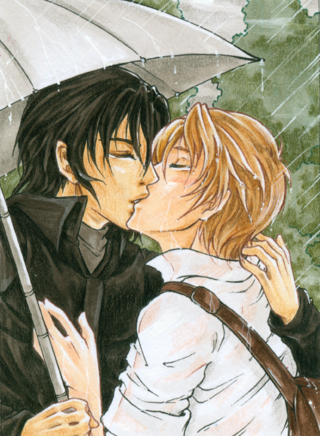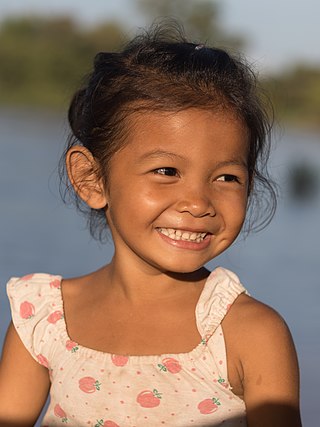Related Research Articles

Flirting or coquetry is a social and sexual behavior involving body language, or spoken or written communication between humans. It is used to suggest interest in a deeper relationship with another person and for amusement.

Boys' love, also known by its abbreviation BL, is a genre of fictional media originating in Japan that depicts homoerotic relationships between male characters. It is typically created by women for a female audience, distinguishing it from homoerotic media created by and for gay men, though BL does also attract a male audience and can be produced by male creators. BL spans a wide range of media, including manga, anime, drama CDs, novels, video games, television series, films, and fan works.

Bishōnen is a Japanese term literally meaning "beautiful youth (boy)" and describes an aesthetic that can be found in disparate areas in East Asia: a young man of androgynous beauty. This word originated from the Tang dynasty poem Eight Immortals of the Wine Cup by Du Fu. It has always shown the strongest manifestation in Japanese pop culture, gaining in popularity due to the androgynous glam rock bands of the 1970s, but it has roots in ancient Japanese literature, the androsocial and androerotic ideals of the medieval Chinese imperial court and intellectuals, and Indian aesthetic concepts carried over from Hinduism, imported with Buddhism to China. Today, bishōnen are very popular among girls and women in Japan. Reasons for this social phenomenon may include the unique male and female social relationships found within the genre. Some have theorized that bishōnen provide a non-traditional outlet for gender relations. Moreover, it breaks down stereotypes surrounding feminine male characters. These are often depicted with very strong martial arts abilities, sports talent, high intelligence, dandy fashion, or comedic flair, traits that are usually assigned to the hero/protagonist role.

Sentō (銭湯) is a type of Japanese communal bathhouse where customers pay for entrance. Traditionally these bathhouses have been quite utilitarian, with a tall barrier separating the sexes within one large room, a minimum of lined-up faucets on both sides, and a single large bath for the already washed bathers to sit in among others. Since the second half of the 20th century, these communal bathhouses have been decreasing in numbers as more and more Japanese residences now have baths. Some Japanese find social importance in going to public baths, out of the theory that physical proximity/intimacy brings emotional intimacy, which is termed skinship in pseudo-English Japanese. Others go to a sentō because they live in a small housing facility without a private bath or to enjoy bathing in a spacious room and to relax in saunas or jet baths that often accompany new or renovated sentōs.

In Japan, pornography has unique characteristics that readily distinguish it from western pornography. Pornographic films are known as "adult videos" (AV) in Japan, so Japanese adult videos (JAV) refers to the Japanese Adult Video industry. Animated films are referred to as hentai in English, but in Japan the terms "adult anime" and "erotic animation" are used. In addition to pornographic videos and magazines featuring live actors, there are now categories of pornographic manga and anime, and pornographic computer games.

In Japanese culture, Kogal refers to the members of the Gyaru subculture who are still in high school and who incorporate their school uniforms into their dress style. These high school girls are characterized by the typical bleached hair, make-up, shortened skirts, and wearing of loose socks. The word kogal is anglicized from kogyaru, a contraction of kōkōsei gyaru.
Enjo kōsai, shortened to enkō (援交), is a type of transactional relationship similar to the Western sugar dating. It is the Japanese language term for the practice of older men giving money and/or luxury gifts to attractive young women for sexual favors. The female participants range from school girls to housewives. The term is often translated as "compensated dating" or "subsidized dating".

Records of men who have sex with men in Japan date back to ancient times. Western scholars have identified these as evidence of homosexuality in Japan. Though these relations had existed in Japan for millennia, they became most apparent to scholars during the Tokugawa period. Historical practices identified by scholars as homosexual include shudō (衆道), wakashudō (若衆道) and nanshoku (男色).

A girl is a young female human, usually a child or an adolescent. While the term girl has other meanings, including young woman, daughter or girlfriend regardless of age, the first meaning is the most common one.

Prostitution in Japan has existed throughout the country's history. While the Prostitution Prevention Law of 1956 states that "No person may either do prostitution or become the customer of it", loopholes, liberal interpretations and a loose enforcement of the law have allowed the Japanese sex industry to prosper and earn an estimated 2.3 trillion yen per year.

Panchira (パンチラ) is a Japanese word referring to a brief glimpse of a woman's underwear. The term carries risqué connotations, similar to the word upskirt in English.
The following is a glossary of terms that are specific to anime and manga. Anime includes animated series, films and videos, while manga includes graphic novels, drawings and related artwork.
"Night hunting", known in Bhutan as Bomena, is a traditional courtship custom that is practiced in some parts of Bhutan. Similar customs have also existed in other cultures, namely in Japan.
Boys' love (BL), a genre of male-male homoerotic media originating in Japan that is created primarily by and for women, has a robust global fandom. Individuals in the BL fandom may attend conventions, maintain/post to fansites, create fanfiction/fanart, etc. In the mid-1990s, estimates of the size of the Japanese BL fandom were at 100,000 to 500,000 people. Despite increased knowledge of the genre among the general public, readership remained limited in 2008.

Class S, or S kankei, abbreviated either as S or Esu (エス), is an early twentieth-century Japanese wasei-eigo term used to refer to romantic friendships between girls. The term is also used to designate a genre of girl's fiction which tells stories about the same, typically focused on senpai and kōhai relationships wherein one girl is senior in age or position to the other. The "S" is an abbreviation that can stand for "sister", "shōjo", "sex", "schön", and "escape".

Geisha (芸者), also known as geiko (芸子) or geigi (芸妓), are female Japanese performing artists and entertainers trained in traditional Japanese performing arts styles, such as dance, music and singing, as well as being proficient conversationalists and hosts. Their distinct appearance is characterised by long, trailing kimono, traditional hairstyles and oshiroi make-up. Geisha entertain at parties known as ozashiki, often for the entertainment of wealthy clientele, as well as performing on stage and at festivals.
Sexuality in Japan developed separately from that of mainland Asia, as Japan did not adopt the Confucian view of marriage, in which chastity is highly valued. Monogamy in marriage is often thought to be less important in Japan, and sometimes married men may seek pleasure from courtesans. Prostitution in Japan has a long history, and became especially popular during the Japanese economic miracle, as evening entertainments were tax-deductible. Decreased sex drive in the 21st century has been blamed for the low Japanese birth rate and declining growth of the Japanese population.

Shōjo manga is an editorial category of Japanese comics targeting an audience of adolescent females and young adult women. It is, along with shōnen manga, seinen manga, and josei manga, one of the primary editorial categories of manga. Shōjo manga is traditionally published in dedicated manga magazines, which often specialize in a particular readership age range or narrative genre.
Originally written in kanji as 硬派, with the character 硬, Kōha refers to the group or people with the features of "hard", "strong," or "tough". In the Meiji era, the opposite word to kōha was nanpa.
Danmei is a Chinese genre of literature and other fictional media that features romantic relationships between male characters. Danmei is typically created by and targeted towards a heterosexual female audience. While danmei works and their adaptations have achieved widespread popularity in China and globally, their legal status remains unclear due to Chinese censorship policies. The female same-gender counterpart to danmei is known as bǎihé, which is an orthographic reborrowing of the Japanese word yuri, but it is not as well known or popular as danmei.
References
- 1 2 Botting, Geoff. "Japanese women on top". The Japan Times , April 8, 2001. Reprinted from Spa!, April 4, 2001. Reviewed November 1, 2010
- ↑ Nihon Kokugo Daijiten 2nd edition. Tokyo: Shogakukan. 2001. ISBN 4095210109.
- ↑ Onishi, Norimitsu (16 September 2003). "Tokyo Journal; A Flashy Teenage Trend Capital, and Its Dark Side". The New York Times.